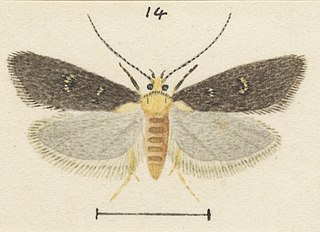Related Research Articles
Brenthia pleiadopa is a species of moth of the family Choreutidae first described by Edward Meyrick in 1921. It is found in Magude, Mozambique.
Cryptolechia ichnitis is a moth in the family Depressariidae. It was described by Edward Meyrick in 1918. It is found in French Guiana.
Prodelaca biseriata is a moth in the family Oecophoridae. It was described by Edward Meyrick in 1920. It is found in Australia, where it has been recorded from Queensland.
Dichomeris asteropis is a moth in the family Gelechiidae. It was described by Edward Meyrick in 1921. It is found in South Africa and Zimbabwe.
Dichomeris corniculata is a moth in the family Gelechiidae. It was described by Edward Meyrick in 1913. It is found in Assam, India and Guangdong, China.
Dichomeris metrodes is a moth in the family Gelechiidae. It was described by Edward Meyrick in 1913. It is found in southern India, Sri Lanka and South Africa.
Athrips profusa is a moth of the family Gelechiidae first described by Edward Meyrick in 1921. It is found in Zimbabwe.
Battaristis orthocampta is a moth of the family Gelechiidae. It was described by Edward Meyrick in 1914. It is found in Guyana.
Antaeotricha iras is a species of moth of the family Depressariidae. It is found in Peru.
Antaeotricha sparganota is a moth of the family Depressariidae first described by Edward Meyrick in 1915. It is found in Guyana.
Synchalara byrsina is a moth in the family Xyloryctidae. It was described by Edward Meyrick in 1907. It is found in India (Assam).
Scorpiopsis rhodoglauca is a moth in the family Depressariidae. It was described by Edward Meyrick in 1930. It is found in Australia, where it has been recorded from Queensland.
Odites heptasticta is a moth in the family Depressariidae. It was described by Edward Meyrick in 1914. It is found in Malawi.
Antaeotricha celidotis is a moth in the family Depressariidae. It was described by Edward Meyrick in 1925. It is found in Peru.
Antaeotricha xuthosaris is a moth in the family Depressariidae. It was described by Edward Meyrick in 1925. It is found in Brazil.
Antaeotricha euthrinca is a species of moth in the family Depressariidae. It was described by Edward Meyrick in 1915. It is found in Colombia.
Phylomictis sarcinopa is a moth in the family Depressariidae. It was described by Edward Meyrick in 1920. It is found in Australia, where it has been recorded from Queensland.
Stenoma crepitans is a moth in the family Depressariidae. It was described by Edward Meyrick in 1918. It is found in French Guiana.
Chlamydastis crateroptila is a moth in the family Depressariidae. It was described by Edward Meyrick in 1918. It is found in French Guiana.

Trachypepla cyphonias is a species of moth in the family Oecophoridae. It is endemic to New Zealand and has been collected in Wellington and Taranaki. Larvae of this species have been reared from kānuka leaf litter. Adults are on the wing in December. This species is classified as "At Risk, Naturally Uncommon" by the Department of Conservation.
References
- ↑ Beccaloni, G.; Scoble, M.; Kitching, I.; Simonsen, T.; Robinson, G.; Pitkin, B.; Hine, A.; Lyal, C., eds. (2003). "Brachynemata restricta". The Global Lepidoptera Names Index . Natural History Museum . Retrieved May 19, 2018.
- ↑ Savela, Markku (January 8, 2014). "Brachynemata restricta (Meyrick, 1920)". Lepidoptera and Some Other Life Forms. Retrieved August 18, 2020.
- ↑ Exotic Microlepidoptera. 2 (10): 310.
 This article incorporates text from this source, which is in the public domain .
This article incorporates text from this source, which is in the public domain .